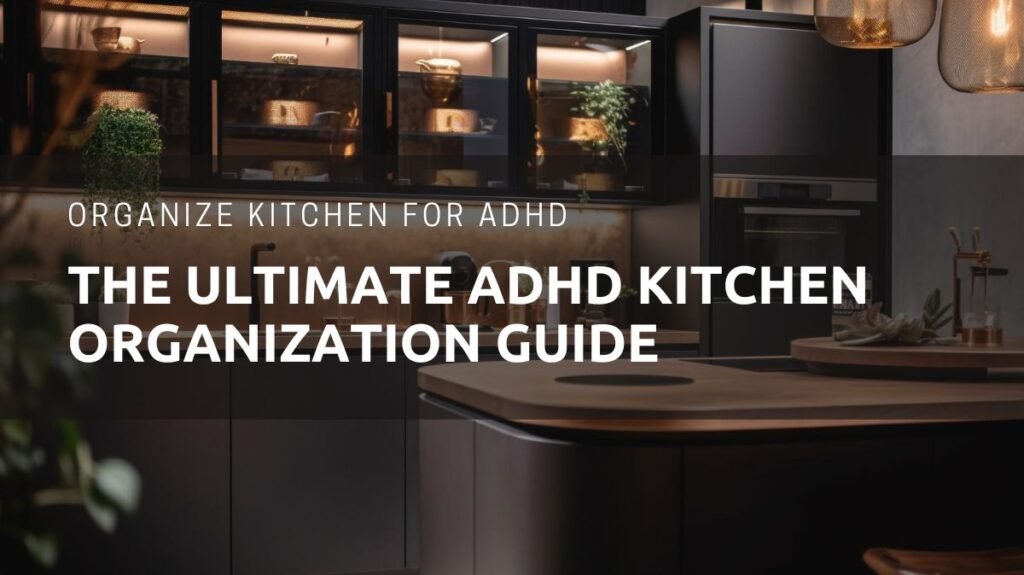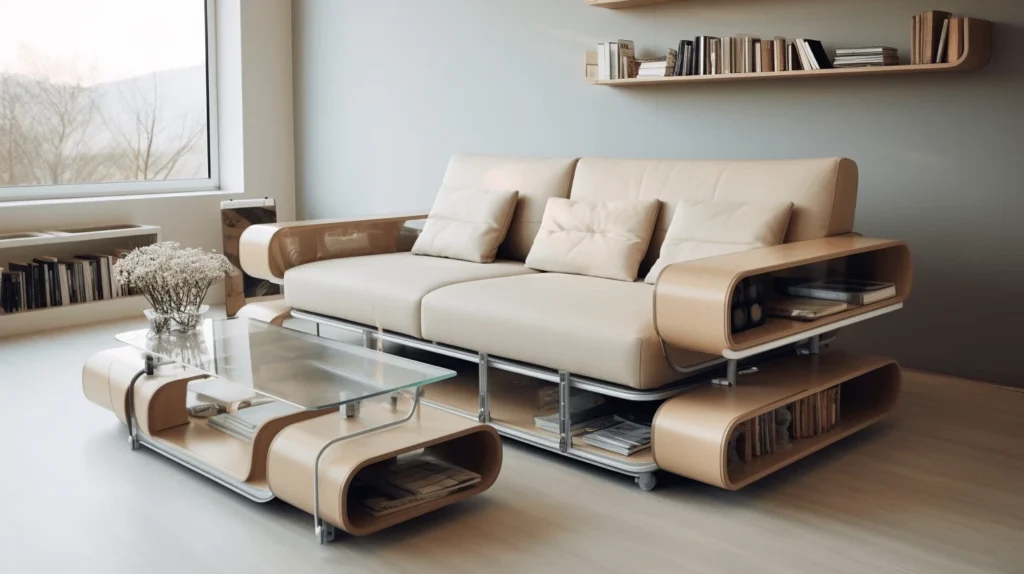Does your kitchen feel like a chaotic war zone? You know, the kind with expired snacks hiding in the back of the pantry, three half-open bags of chips, and that one spatula you swear vanished into thin air. If this sounds familiar, you’re definitely not alone!
Let’s face it, most ADHD kitchen organizing advice out there isn’t designed for brains like ours. It expects us to love perfectly labeled bins tucked away and elaborate meal plans. But the truth is, those things can make us want to give up before we even start!
Don’t worry, this guide is all about ditching that perfectionist pressure. We’re going to figure out WHY kitchen organization is such a struggle for those of us with ADHD. Then, together we’ll build systems that actually support how our brains work.
Spoiler alert: it’ll involve ditching some of those “shoulds” you might have picked up along the way. The goal is a kitchen that feels less like a battleground and more like a tool to help you tackle meals (and life!) with a little more ease.
Ready to get started?
Understanding ADHD and Kitchen Organization
Let’s be real: the kitchen is a place where a lot of our ADHD challenges can show up in full force. It’s NOT about being lazy or not caring. It’s about how our brains process information and manage tasks. Here’s the lowdown:
- Executive Functioning: Remember those superpowers like planning, organization, and getting stuff done? Yeah…they sometimes take a vacation when we step into the kitchen. This makes it hard to remember what ingredients we have, stick to a recipe, or tackle the cleanup without feeling like it’s the most overwhelming thing ever.
- The “Out of Sight, Out of Mind” Curse: You know that drawer you try to avoid? The one where tools seem to disappear? That’s prime ADHD territory! When we can’t SEE things, they basically cease to exist in our minds. This leads to wasted food, impulsive buys, and that panicked “where the heck is the can opener?” moment.
- Decision Fatigue is REAL: Staring at a packed pantry or fridge trying to figure out dinner? Ugh, it’s enough to make anyone reach for the takeout menu! All those choices can overwhelm our brains, leading to unhealthy snacking or giving up on cooking entirely.
- Sensory Overload: Ever felt like the visual clutter, constant mess, and general disarray of your kitchen is like someone cranking the volume dial in your brain? For some of us with ADHD, that’s a real thing, making this space even harder to manage.
So, are you ready to transform your kitchen into one that works FOR you, not against you? Let’s do this!
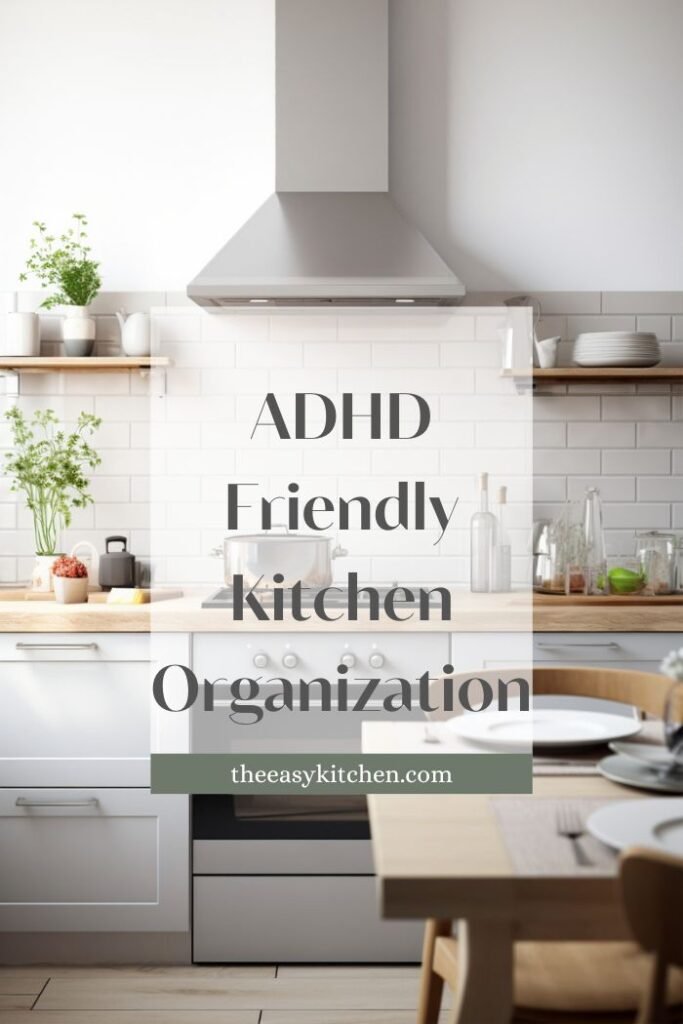
Key Principles for an ADHD-Friendly Kitchen
Forget those magazine-perfect kitchens with everything neatly hidden away. An ADHD-friendly kitchen is about function, not just looks. These core ideas will guide our makeover:
- Visuals are Key: If you can’t see it, it might as well not exist. Open shelving, clear containers, and ditching unnecessary cabinet doors are game-changers for staying on top of your supplies and tools.
- Accessibility Rules: The things you use most often need to be in the easiest-to-reach spots. Think about where you actually do your cooking tasks and put stuff accordingly. No more digging to the back of a bottom shelf for the one pan you always use!
- Fight Decision Fatigue: We’ll tackle ways to simplify your pantry staples, create go-to meals, and minimize the stress of “what’s for dinner?”. The easier the decision, the greater the chance you’ll actually do it!
- Location, Location, Location: Analyze how you move around your kitchen while cooking. Place the spices near the stove, put the dishes close to the dishwasher…you get the idea. The less unnecessary running around, the better.
Important Note: These principles are guidelines, not rigid rules. The best ADHD-friendly kitchen is the one that works for YOU. We’ll cover tons of specific strategies in the upcoming sections, so start thinking about what changes would make the biggest difference in your daily life!
ADHD-Friendly Kitchen Tools and Gadgets
With ADHD, we need tools that work WITH us, not against our natural tendencies. Here’s some of our favorite gadgets for creating a functional (and sanity-saving) space:
- The Organizational Powerhouses
- Drawer Dividers: Your New Best Friend Ever feel like your cutlery drawer is staging a utensil rebellion every time you open it? Dividers are a gamechanger! No more digging through a jumbled mess or playing “Where the heck did that spatula vanish to this time?”
- Under-Shelf Baskets Magic: You know those shelves that are so awkwardly high you basically need a step stool to see? Under-shelf baskets to the rescue! Grab what you need without feeling like you’re dismantling a Jenga puzzle.
- Turntables: No More Forgotten Foods Imagine a world where those spices or random cans in the back of the pantry don’t disappear forever! Turntables mean everything is visible and within reach – preventing a frantic search AND saving you from buying something you already have at home.
- Clear Containers: X-Ray Vision for Your Groceries See how much pasta you have left in seconds! Clear containers take the guesswork out of meal planning and grocery shopping. Plus, they prevent that sinking feeling when you find a long-expired mystery item lurking in the back of the shelf.
- Label Maker: Not just for the super-organized – labels clarify what goes where for everyone in the house and make resetting the kitchen a breeze (even if you didn’t do the original organizing).
- Meal Planning Heroes
- Whiteboard: Whether it’s your weekly meal plan, a simple “use this by” reminder, or a grocery list, a whiteboard centralizes info where you’ll see it, minimizing those “Wait, do we have…?’ moments.
- Meal Planning Templates: These give structure if the blank slate feels overwhelming and help cut down on decision-making stress. Search online for free printables or try an app that fits your style.
- Multiples FTW!
- Have at least two of the things you lose most often – think spatulas, whisks, and measuring cups. Saves you mid-meal when one inevitably vanishes or is in the dishwasher.
- Have at least two of the things you lose most often – think spatulas, whisks, and measuring cups. Saves you mid-meal when one inevitably vanishes or is in the dishwasher.
- Tech to the Rescue:
- Smartwatches: Timers and reminders are gamechangers! Prevent burned meals, forgotten ingredients, and that sinking feeling when you overschedule yourself.
- Visual Timers Like the Time Timer show time passing with a clear visual cue, which can be way more helpful than just a beeping noise, especially if auditory distraction is an issue for you.
- Sensory Support
- Struggle with overstimulation in the kitchen? Consider a silent timer, noise-canceling headphones for cleanup time, or a motion-sensor trashcan to minimize some of those startling sounds and tasks.
Important Note: This isn’t a must-have shopping checklist! Prioritize the tools that would make the biggest difference for YOUR specific challenges. It’s about working smarter, not just buying more stuff.
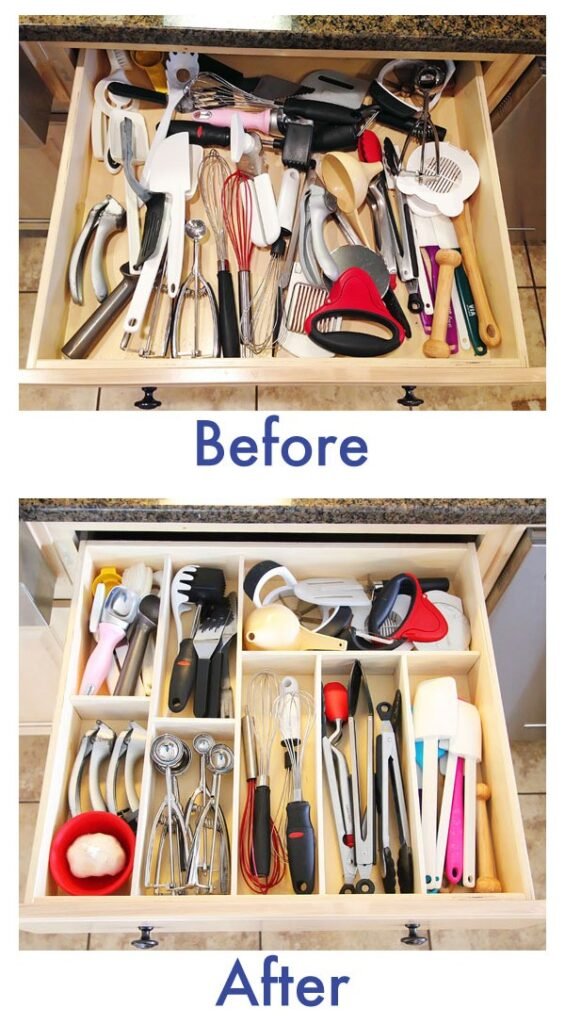
Feeling inspired? Let’s dive into specific strategies for conquering those notorious problem areas – your pantry, fridge, cabinets, and those pesky countertops!
Specific ADHD Kitchen Organization Strategies
Let’s turn those problem zones into a source of ease! Here’s how to create systems that support your needs and minimize those classic ADHD struggles:
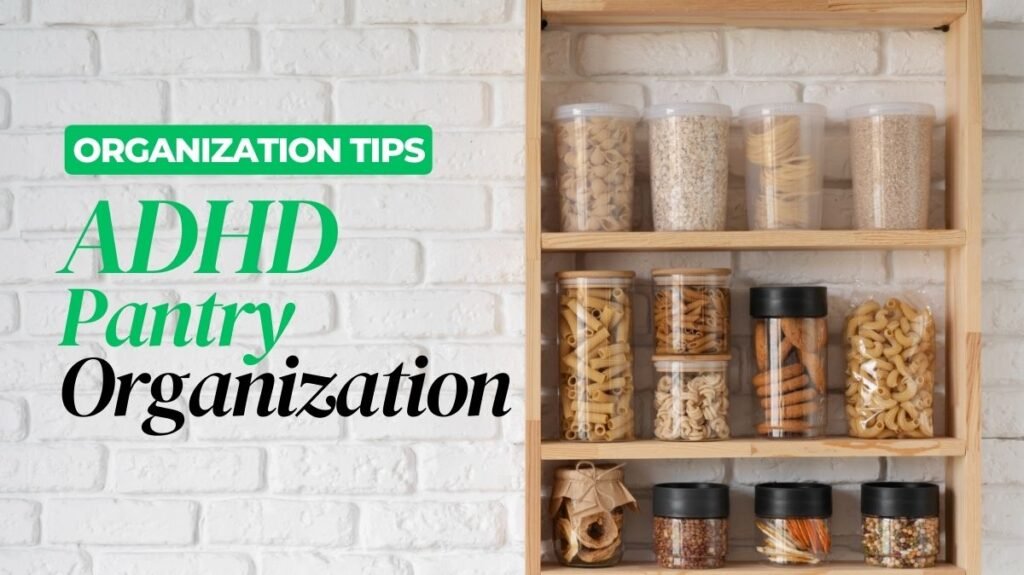
Pantry Power-Up: ADHD Pantry Organization Tips
- Decanting for Visual Clarity: Transferring cereal, flour, snacks, etc. into clear containers instantly reduces the visual clutter of mismatched boxes. This makes it easier for our brains to quickly register what’s available, streamlining both meal planning and those “do we have anything to eat?” moments.
- The “One In, One Out” Rule: Maintain control over stock by only buying a replacement of something once the old one is finished. This combats the impulsive overbuying that can plague us when faced with too many choices.
- Categorize AND Prioritize: Group similar items together (pasta, baking stuff, canned goods). Within each category, place what you use most often at eye level and within easy reach. Minimize those frustrating moments of searching the back of a shelf for something you know is there!
- Expiry Check Zone: A dedicated bin or basket for things nearing their “best by” date provides a gentle visual reminder to prioritize those items. This prevents them from becoming forgotten casualties molding in the shadows of your pantry.
- Bonus Tip: Rotate stock so older items are in front. This helps ensure things are used before their expiry, combatting wasted food and impulsive “I need this!” purchases when you already have a version at home.
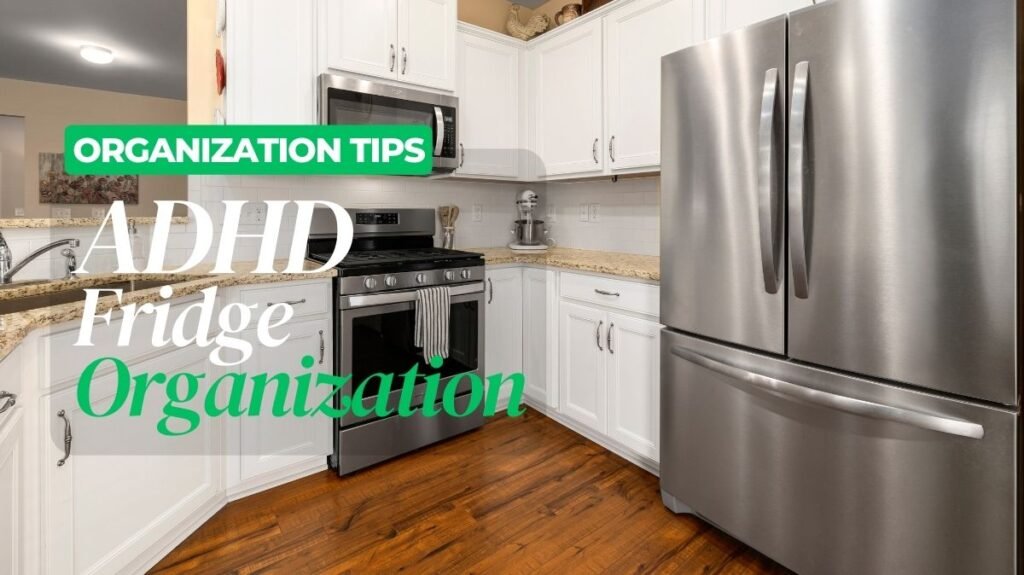
Refrigerator Rescue: ADHD Fridge Organization Tips
- Bins are Your Best Friend: Clear bins labeled “produce,” “snacks,” “leftovers,” etc. create an instant system that supports our need for visual cues. No more digging for the yogurt hidden behind a wall of takeout leftovers!
- Top Shelf Visibility: Designate the top shelf for things that MUST be used soon – leftovers, opened produce, that deli meat you bought on a whim. This helps them stay front of mind and prevents them from disappearing into the fridge abyss.
- Whiteboard Magic: A simple whiteboard on the fridge door has endless possibilities. It can be your go-to spot for meal planning, listing items to use up quickly, or even leaving little reminders to yourself throughout the day.
- Minimize the Mystery: If storing leftovers or prepped ingredients, label containers with the contents AND date. This cuts down on the “what IS this” and “when did I buy this?” anxiety that can plague us.
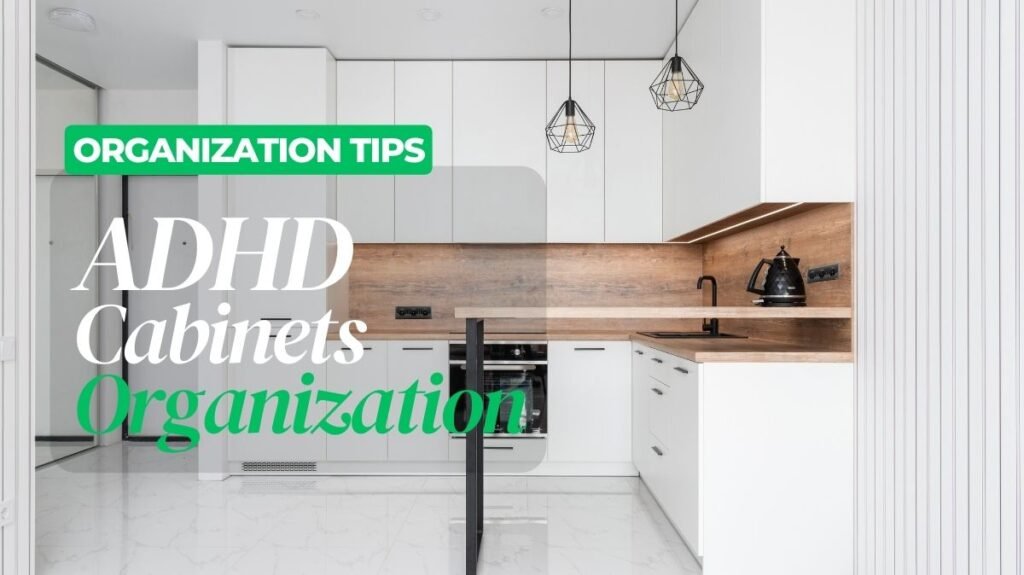
Cabinet and Drawer Domination: ADHD Cabinet Organization Tips
- Stacking Solutions: Maximize vertical space with shelf risers or stackable bins. This is especially crucial in those awkward deep cabinets where things seem to disappear. No more stacking precariously tall towers of cans!
- Drawer Dividers for the Win: They prevent your utensil drawer from becoming a jumbled mess where finding the right spoon requires an archaeological dig. Your future self will thank you for this one.
- Pull-Out Drawers (If Possible): These are a lifesaver if you have deep cabinets. No more crouching and contorting your body to see what’s hidden at the back – reducing a major frustration point for many!
- Label Everything: Labels aren’t just for the inside of drawers and cabinets. Putting them on the fronts too minimizes that frantic opening and closing multiple compartments while searching. Those of us with ADHD know this frantic search all too well!
- Accessibility is Key: Think about where you tend to stand when preparing meals and snacks, and try to place frequently used items in those corresponding cabinets and drawers. This reduces those extra steps that can easily derail us as we’re trying to get a task done.
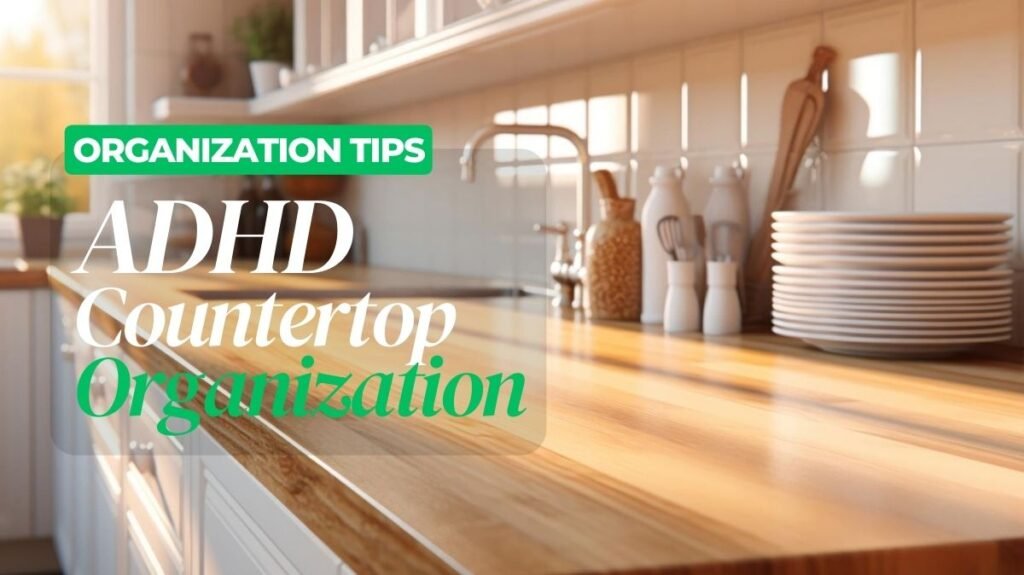
Conquering Countertop Chaos: ADHD Countertop Organization Tips
Countertops are prime ADHD problem zones – they easily become dumping grounds for mail, keys, random gadgets, and half-finished projects. Here’s how to create more clarity and prevent that cluttered feeling:
- The Appliance Corral: If possible, designate a specific area or cabinet with a door where your most-used appliances can live. When not in use, hiding them away reduces visual clutter, which is extremely helpful for the ADHD brain.
- The “Does it DESERVE this Space?” Test: For EVERYTHING else vying for countertop real estate, ask yourself: do I use this multiple times per day, every single day? If not, it needs to find a proper home elsewhere in the kitchen or even in another room entirely. Be ruthless! This minimizes decision fatigue and helps prevent your counters from becoming a catch-all for random things.
- Attractive AND Accessible: For those essential items you DO need at arm’s reach, consider investing in attractive containers or canisters. This not only ups the visual appeal but encourages you to maintain the system because it looks nice! A messy container with an open lid is far less likely to be used.
- Think Outside the Countertop: Use wall-mounted solutions like magnetic knife strips, hooks for utensils, pot racks, fruit baskets hung under cabinets… all of these free up precious counter space and can even add a bit of personality to your kitchen.
Example: Perhaps you always have a jar of granola and a fruit bowl out for easy breakfast access. Or a beautifully designed utensil crock becomes your “only thing that stays on the counter next to the stove” item while cooking.
Important note: This is an area where what works is VERY individual. Some folks want absolutely nothing on their counters, while others find a few carefully curated items helpful. Don’t compare yourself to what others are doing or judge your efforts based on what works for them!
Ready to see a difference in your kitchen? Great! Let’s talk about conquering those countertops and creating routines that keep your progress from backsliding.
ADHD, Decision-Making, and Routine
Let’s be honest – even with the best organization systems in the world, it can be hard to stay consistent, especially with ADHD. Here are some strategies to break free from overwhelm and support yourself in the long term:
- Time Limits to the Rescue: Set a timer (10 minutes is a great start) for those looming tasks like “sort the random kitchen drawer” or “choose recipes for the week.” This provides focus and combats procrastination.
- The Master Meal List: Instead of trying to reinvent the wheel for every dinner decision, start with a list of 10-20 familiar meals your family enjoys. This reduces decision fatigue when that “what’s for dinner?” fatigue hits. You can always add new meals over time, but having a base to start with is a major win.
- Routine is Your Friend: Don’t underestimate the power of small, consistent habits. This could be:
- The 5-Minute Reset: Take a few minutes at the end of the day to do a quick kitchen tidy. This keeps things from spiraling into overwhelming messes and helps prevent avoidance.
- “Start Clean, End Clean”: Whether it’s taking an extra 10 minutes to do the dishes after dinner, or a quick wipe down of the counter after breakfast, these tiny routines create a sense of calm and control.
- Linking Habits: Tie kitchen tasks to other daily habits: Do you always make coffee in the morning? While it’s brewing, unload the dishwasher. Building in kitchen care as part of your routine makes it feel less daunting.
Important Reminder: Routines take time to establish! Don’t get discouraged if it’s bumpy when you first start. Celebrate those tiny wins of consistently unloading the dishwasher for a few days or remembering to do a nightly countertop wipe-down. That builds momentum.
Of course! Here’s a detailed look at how to maintain your newly organized kitchen, with specific emphasis on the ADHD experience:
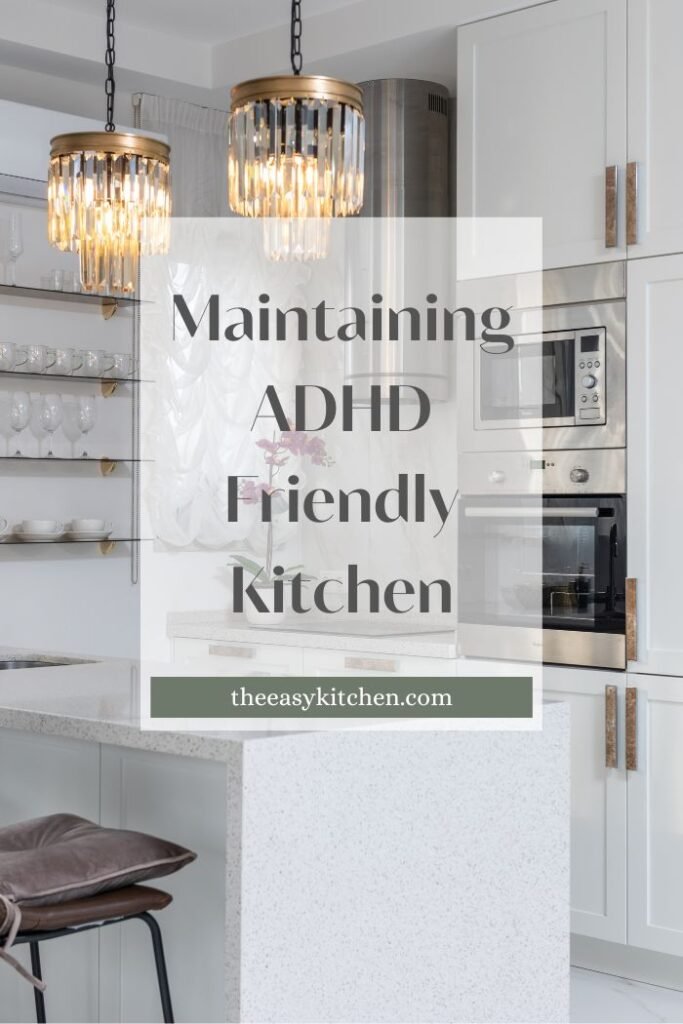
Tips for Maintaining Your ADHD-Friendly Kitchen
The hard truth is that no organization system lasts forever without some upkeep. The good news is, with our strategies in place, it’ll be far less agonizing than before!
Here’s how to maintain an ADHD-friendly kitchen:
- The 5-Minute Reset, Your Secret Weapon: Seriously, those quick bursts of tidying in the morning, after cooking, or before bed stave off the overwhelming “my kitchen is out of control” feeling that can easily lead to giving up. Think of them as preventative medicine for kitchen chaos!
- Celebrate Progress, Not Perfection: Did you manage to keep your counters mostly clear for a week? Were leftovers consistently put away? Those are all major victories! Perfectionism can sabotage the best efforts, so focus on celebrating your progress, no matter how small it might seem.
- Adapt as You Go: Life changes, and so do your needs. What worked perfectly a month ago might not be ideal today. That’s perfectly normal! Don’t be afraid to re-evaluate. Maybe that container you designated for snacks needs to be repurposed because your snack preferences have changed. Embrace the flexibility and remember: it doesn’t have to look exactly like it did on “Day One” to still be successful.
- Asking for Help is Smart, Not Weak: Organizing isn’t a solo sport! Ask a friend or partner to help you with a particularly messy spot, bounce ideas for a tricky area, or offer accountability to keep up with those 5-minute resets. If tackling a major kitchen overhaul, consider hiring a professional organizer, especially those experienced with ADHD, for practical solutions and support.
- When Things Slip… It WILL happen! Don’t view setbacks as a personal failure or evidence that “you can’t do this”. Instead of giving up, take a moment, analyze what happened (did the system break down? Did a change in your routine derail you?), and then troubleshoot the solution. It’s a constant process of trial and error, and that’s okay.
Remember: An ADHD-friendly kitchen is about giving yourself tools for success and reducing the stress of daily tasks. It’s NOT about becoming Pinterest-perfect or forcing yourself into a mold that doesn’t fit your brain. Be kind to yourself as you navigate this process!
Frequently Asked Questions
1. My kitchen is tiny. Can I even make these changes work for me?
Absolutely! Focus on maximizing vertical space to squeeze out every bit of potential storage. This includes:
1. Wall-mounted solutions: hooks for utensils, magnetic spice racks, even hanging fruit baskets under upper cabinets.
2. Under-shelf baskets: Gain extra surfaces for lighter items.
3. Over-the-door organizers: Great for pantry doors, storing snacks, or cleaning supplies.
4. Prioritize “multi-use”: Think nesting bowls, stackable containers, and choosing tools that serve multiple purposes.
2. I’m on a tight budget. Where do I start first?
Focus on the wins that are both cheap and high impact!
1. Repurpose and Reuse: Glass jars, sturdy boxes you were going to toss – they can all become containers for pantry items.
2. Labels: Even ones printed on paper and taped on make a surprising difference in keeping track of things.
3. Rethink Your Inventory: Use up what you have, shop sales, and simplify your pantry staples before committing to buying fancy organizing gear. A pared-down system is easier to maintain regardless of budget.
3. My family refuses to help! What do I do?
It’s frustrating, that’s for sure! Try these strategies:
1. Age-appropriate tasks: Even toddlers can put away their own snacks on a low shelf. Older kids can manage larger zones.
2. Visual Help: Charts, chore checklists with pictures, and even labeling shelves where things belong make it easier for everyone to follow through.
3. Focus on Your Zones: You can’t control the whole kitchen, but you CAN keep your frequently used areas organized. This lessens your burden and sets a good example.
4. I get so overwhelmed that I give up. How do I stick with it?
Tiny wins are KEY! This is NOT about transforming your kitchen overnight.
1. Pick ONE problem zone: A single drawer, the pantry shelf that drives you nuts…start there. Success breeds more success.
2. Set REALISTIC expectations: If you usually neglect the kitchen for weeks, aiming for daily resets isn’t happening yet. Start with the goal of, “I will put away the dishes within a day of using them.”
3. Seek Support: Have an ADHD-savvy friend you can text when you’re feeling defeated, join an online group, or consider working with a therapist or professional organizer for that extra boost of accountability and guidance.
5. Will I ever be able to maintain this way of organizing?
There WILL be slip ups, that’s unavoidable. The difference is, now you have the tools and the knowledge of why those traditional methods weren’t working. When things inevitably get messy, you’ll be able to bounce back more quickly and recognize how to tweak things for better success. Be kind to yourself as this becomes your new routine!
Your ADHD-Friendly Kitchen: A Place of Calm and Control
Remember, transforming your kitchen is a journey, not a sprint. Celebrate each win, big or small, and be patient with yourself along the way. By choosing strategies that work with your ADHD brain, you create a space that supports you in managing meals and groceries with less stress and overwhelm. You deserve a kitchen that brings you a sense of calm, not chaos!
Think about the difference between feeling overwhelmed by your current kitchen and walking into one with a sense of clarity. That’s within your reach!
Let’s recap the key benefits you’ll start experiencing:
- Reduced Stress: No more frantic searches for ingredients, wasted food due to forgotten items, or that sinking feeling when you open your pantry or fridge. This creates a greater sense of calm throughout your entire day.
- Healthier Choices: When you know what you have and your go-to meals are planned, healthy eating decisions become easier. Less impulsive takeout or unhealthy snacking driven by kitchen disorganization!
- Boosted Confidence: Every time you successfully use your new tools and systems, you’re sending a positive message to your brain: “I can manage this!” That newfound confidence extends to other areas of life, especially those that involve similar organizational challenges.
- Time and Energy Saved: What will you DO with the time and mental energy you reclaim from conquering kitchen chaos? The possibilities are endless!
This is Just the Beginning! Keep experimenting, tweaking, and celebrating your progress. If you want further support, here are some resources to consider:
- Websites & Blogs: Find and join some good ADHD blogs like CHADD blog, and check the ADHD resources shared.
- Online Support Groups: Join a community of others with ADHD who can share challenges and triumphs related to organization and household management.
- Professional Organizers: If you’d like personalized assistance, consider working with a professional organizer who specializes in ADHD-friendly solutions.
Remember: You’re not alone in this journey. With the strategies we’ve explored, your kitchen can become a source of ease and empowerment, supporting you in all areas of your life. Now go and reclaim your kitchen!
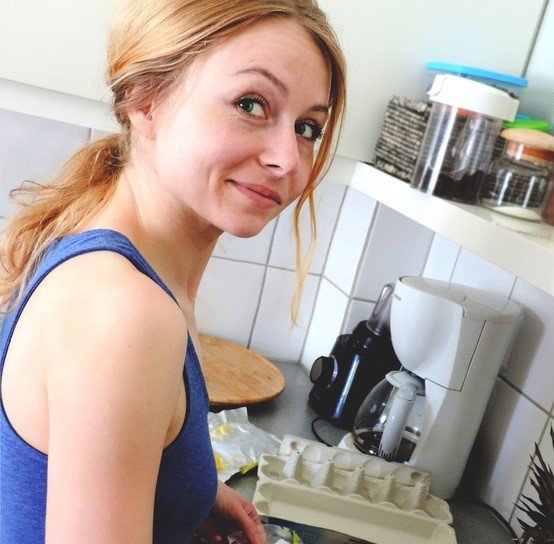
Editorial Director at The Easy Kitchen, she combines her extensive experience in the food and drink industry with a passion for kitchen innovation. With a background in kitchen management, recipe development, and product testing, Della offers readers a wealth of knowledge on cooking techniques, kitchen organization, and the latest culinary gadgets. Her articles aim to inspire cooks of all levels to explore new flavors and streamline their cooking process. When she’s not leading the editorial team or experimenting with new recipes, Della enjoys sharing her insights on creating efficient and enjoyable kitchen spaces.

